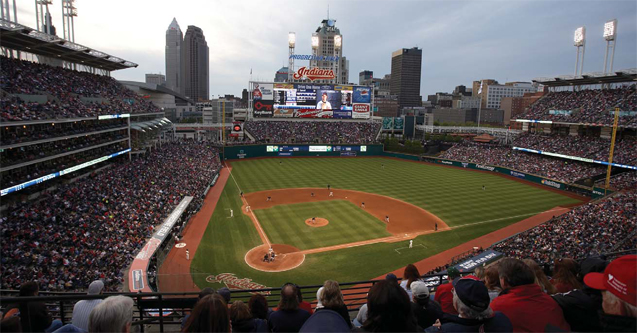A bothersome delay caused fans in ballpark lounges and suites to see the action moments after it happened in Progressive Field, home of the Cleveland Indians.
- CLEVELAND, OH—Tensions were running high at the Club Lounge in Progressive Field, the Cleveland Indians’ ballpark. There, as patrons watched games on a 42-inch Toshiba 42LX196 HDTV, they could hear the roar of the crowd from outside whenever one of the Tribe’s big bats put wood on the ball, but the fans in the lounge wouldn’t know it had been smacked over the outfield wall until several heart-stopping seconds later when it finally appeared on their screen.
- The situation wasn’t much better in the high-priced luxury suites. “When you are watching a ballgame on a high-definition screen in one of our 130 luxury suites—where you also have a great view of the field—reality should happen in real time,” said Jim Folk, vice president of ballpark operations at Progressive Field. “But when we started to install HD screens in our luxury suites, we found that when we took the off-the-air broadcast signals of the game back into our system, there was a very bothersome delay. It was a five-second lag at least, and that can be very annoying.”
- To set things straight, the folks at Progressive Field turned to Rex Rickly, who is the director of special projects at WKYC-TV, Channel 3 serving the Queen City on the shores of Lake Erie. In 2007, Rickly also worked for the Indians as manager of technical services and he was given the task to fix the irksome delay in the loge boxes.
- Rickly’s solution was to install an in-house HD channel that was backfed directly from the studio control room at WKYT-TV. They fed HDSDI from the control room to the ballpark, ran it into an encoder, and then through a 64 QAM (Quadrature Amplitude Modulation) modulator into the cable system that runs throughout the ballpark.
A key component for the new system at Progressive Field is an encoder that can compress the high-definition signal into MPEG-2 to be sent to the HD screens. After some searching, the NCoder HD made by the DVEO division of Computer Modules was chosen.A key component that Rickly had to choose for this new system was the encoder that would compress the high-definition signal into MPEG-2 to be sent to the HD screens. After some searching, Rickly chose the NCoder HD made by the DVEO division of Computer Modules.
“At the time we were looking [in early 2007], the NCoder HD had the lowest latency in a cost-efficient encoder design,” Rickly explained. “It was also important to us that DVEO’s NCoder had been successfully deployed at the AT&T Center in San Antonio, TX, where it was used for sportscasts of the San Antonio Spurs, San Antonio Rampage, San Antonio Silver Stars, and the San Antonio Livestock Show & Rodeo. We talked with the people in the Texas facility and their assurances gave us confidence that the NCoder would solve our problems.”
The NCoder HD’s extremely low latency is the result of DVEO’s proprietary software algorithms, and in addition to the speed advantages of the slim Linux operating system it uses Flash memory to avoid the delay inherent in getting a signal onto and off of a hard drive. Thanks to its IP interface, the NCoder can be controlled through a browser from anywhere with web access.
“DVEO was very good about working with us when I first set up the NCoder HD,” Rickly said “They helped us figure out what bit rates to choose and where the sweet points were.”
Once the system was installed, the team at Progressive Fiels had virtually no problems with the encoder or any HD video delay.










